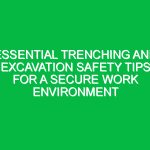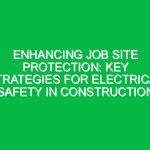When it comes to construction sites, ensuring the safety of all personnel is paramount. Among the myriad of hazards present, falls from heights remain a leading cause of injury and fatality. This is why fall protection planning is not just a regulatory requirement but a moral imperative. In this ultimate guide, we delve into the essentials of fall protection planning to ensure safety on construction sites, covering everything from risk assessment to the implementation of fall protection systems.
Understanding the Importance of Fall Protection
Fall protection is a critical component of Health Safety and Environment (HSE) practices in the construction industry. It involves implementing safeguards to prevent falls or to minimize the impact should a fall occur. The goal is clear: to ensure that every worker goes home safely at the end of the day.
Conducting a Risk Assessment
Before any work begins, a thorough risk assessment must be conducted. This involves identifying potential fall hazards, such as unprotected edges, holes, or unstable surfaces. Once these hazards are identified, the risk they pose can be evaluated, and appropriate control measures can be planned.
Identifying Fall Hazards
- Unprotected Edges: These are the most common fall hazards on construction sites. Any edge that lacks guardrails or similar protective measures is a risk.
- Holes in the Floor: These can be overlooked but pose a significant risk, especially on upper floors.
- Unstable Working Surfaces: These include any surface that is not securely fixed or that could shift under a person’s weight.
Planning Control Measures
After identifying and assessing the risks, the next step is to plan control measures. These can be categorized into three main types: elimination, prevention, and protection.
Elimination
The most effective control measure is to eliminate the hazard entirely. This could involve changing the design or work processes so that work at height is not required.
Prevention
Where elimination is not possible, the next best option is to prevent falls. This can be achieved through the use of guardrails, safety nets, or personal fall arrest systems (PFAS).
Protection
When falls cannot be prevented, protective measures must be put in place to minimize the impact. This includes the use of personal protective equipment (PPE) like harnesses and lanyards, designed to arrest a fall safely.
Implementing Fall Protection Systems
Implementing fall protection systems involves more than just purchasing equipment. It requires careful planning to ensure that the systems are suitable for the specific tasks and hazards present on the construction site.
Guardrails
Guardrails are one of the most effective means of preventing falls. They should be installed around all open edges, holes, and other fall hazards.
Safety Nets
Safety nets can be used as a passive form of fall protection, catching workers if they fall. They are particularly useful when work is being done at significant heights.
Personal Fall Arrest Systems (PFAS)
PFAS are an essential part of fall protection for workers who must work at heights where guardrails or safety nets are not feasible. They consist of a full-body harness, a lanyard, and an anchor point, and they must be carefully selected and fitted to each worker.
Training and Education
An essential component of fall protection planning is training. Workers need to be educated on the risks, the equipment, and the procedures that are in place to protect them. This includes how to properly use and maintain their personal protective equipment (PPE), how to recognize hazards, and what to do in the event of a fall.
Regular Inspections
Regular inspections of fall protection equipment and systems are crucial to ensure their effectiveness. This includes checking guardrails, safety nets, and PFAS for signs of wear or damage.
Creating a Culture of Safety
Ultimately, the success of any fall protection plan depends on the culture of safety within the organization. This means going beyond mere compliance with regulations and fostering an environment where safety is everyone’s priority.
Encouraging Reporting
Workers should be encouraged to report potential fall hazards or any issues with equipment. A proactive approach to safety can help prevent accidents before they happen.
Summary of Key Points
- Fall protection planning is essential for ensuring safety on construction sites.
- A thorough risk assessment is the first step in identifying potential fall hazards.
- Control measures can be categorized into elimination, prevention, and protection.
- Implementing fall protection systems requires careful planning to ensure they are suitable for the specific tasks and hazards.
- Training and education are crucial components of fall protection planning.
- Regular inspections of equipment and systems are necessary to ensure their effectiveness.
- Creating a culture of safety is essential for the success of any fall protection plan.
Ensuring the safety of workers on construction sites is a complex task that requires careful planning, the right equipment, and ongoing education. By following the guidelines outlined in this ultimate guide to fall protection planning, construction sites can mitigate the risks associated with working at heights, ensuring that every worker has the protection they need to perform their duties safely. Remember, the goal of fall protection is not just to comply with regulations but to ensure that every worker goes home safely at the end of each day.


